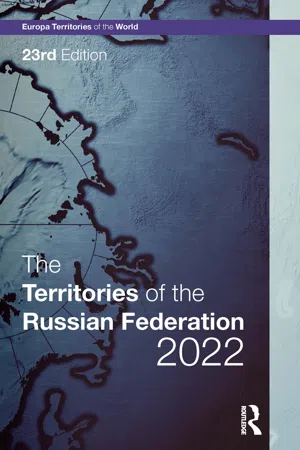INTRODUCTION
Many features of the federal structure within the Russian Federation originate in the Union of Soviet Socialist Republics (USSR). In principle, the Soviet system was highly centralized from its creation in 1922, with the Moscow-centred ruling party, the Kommunisticheskaya Partiya Sovetskogo Soyuza (KPSS—Communist Party of the Soviet Union), retaining practical and symbolic supremacy across the land. Nevertheless, the communist leadership could not ignore regional affairs. In order to accommodate national aspirations the USSR from the outset allowed territorial units to exist within the Union Republics; such territorial units were often dedicated to specific ethnic groups in a multinational state. Furthermore, individual Soviet leaders depended on regional strongholds in order to secure power or recognition within Union-wide institutions. Thus, Leonid Brezhnev attained high office, including 18 years (1964–82) as General Secretary of the KPSS, not least due to his professional origins in the east of the Ukrainian Soviet Socialist Republic. Moreover, regional elites could build power bases with autonomous features. Such power could be built on charismatic authority, or on the importance that a given region held for the Union as a whole, such as the West Siberian regions containing significant hydrocarbon reserves.
Following the disintegration of the USSR in 1991, the President of the Russian Federation, Boris Yeltsin, held a significant public profile, and was personally linked to the rapid political and economic transformations that enveloped Russia in the 1990s. Meanwhile, although Yeltsin sought to retain a substantial role for Russia and for himself on the world stage, he could not ignore the plight of Russia’s regions, most of which regularly appealed to his Government for economic support in the face of a crumbling economy and decaying infrastructure. Yet the Yeltsin administration often lacked the capability to assist, and was also forced to enter into specific agreements with those regions from which his Government could gain particular benefits, such as the energy-rich Republic of Tatarstan. Despite Yeltsin’s success in holding the Russian Federation together during these troubled years, the resulting state—as formalized in the 1993 Constitution—was an unwieldy amalgam of ill-defined prerogatives divided between central and regional authorities, which repeatedly led to prolonged regional dissatisfaction or simply non-compliance with federal demands.
Nowhere was this more obvious than in the bloody conflict which erupted in Chechnya in 1994. While it could be argued that the conflict demonstrated the willingness of the central state to oppose and destroy violently any serious regional challenge to its political supremacy, it was also telling that the Yeltsin administration would go to such lengths to keep control over what in many ways amounted to an inconsequential region. Although the military attack stymied Chechen statehood, consequences for the centre were dire. The intensive fighting for more than 18 months resulted in the deaths of thousands of civilians and soldiers, and presented a stark, chaotic image far from the federal stability and harmony sought by Yeltsin.
When Vladimir Putin became premier and subsequently President in 1999–2000, his growing popular support was built on the perception that he would turn such chaos into order. Taking advantage of the disputed circumstances surrounding the terrorist bombings in Moscow and other Russian cities in August–September 1999, Putin restarted the war in Chechnya. While his early approach to the North Caucasus region was aggressive, Putin presented himself as a modern, rational leader of a state with huge economic potential, offering deals to political and economic elites throughout the country. In addition, the rise of Putin was accompanied by substantial power shifts within the regions. Notably, allies from his home city of St Petersburg began to replace the Muscovite elites remaining from Yeltsin’s tenure. Other political and economic challengers were more worrisome for Putin, although the retreat from the 2000 presidential election by former premier and Minister of Foreign Affairs Yevgenii Primakov, who had been supported by Moscow Mayor Yurii Luzhkov, represented an early defeat by Putin of a significant regional-based challenger.
In place of such political veterans, ambitious oligarch Mikhail Khodorkovskii gained in economic and political influence, having attempted to build a personal political power base outside the federal Government, notably through his energy company, Yukos. Thus, it was a significant boost to Putin’s centralization of Russian power when Khodorkovskii was arrested in 2003 and subsequently imprisoned for alleged economic crimes. Having removed the most significant of the remaining oligarchs from the Yeltsin era, Putin then sought to control Russia’s regions by spreading the dominance of Yedinaya Rossiya (YeR—United Russia). By 2003 the party (initially formed in 2001) already controlled almost one-half of the seats in the lower legislative chamber, the Gosudarstvennaya ...
